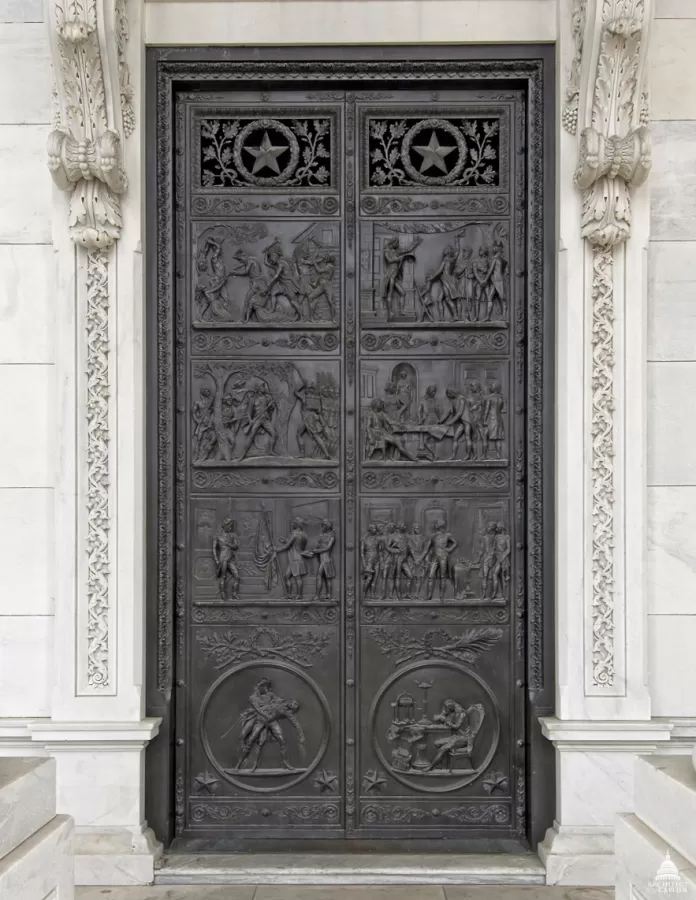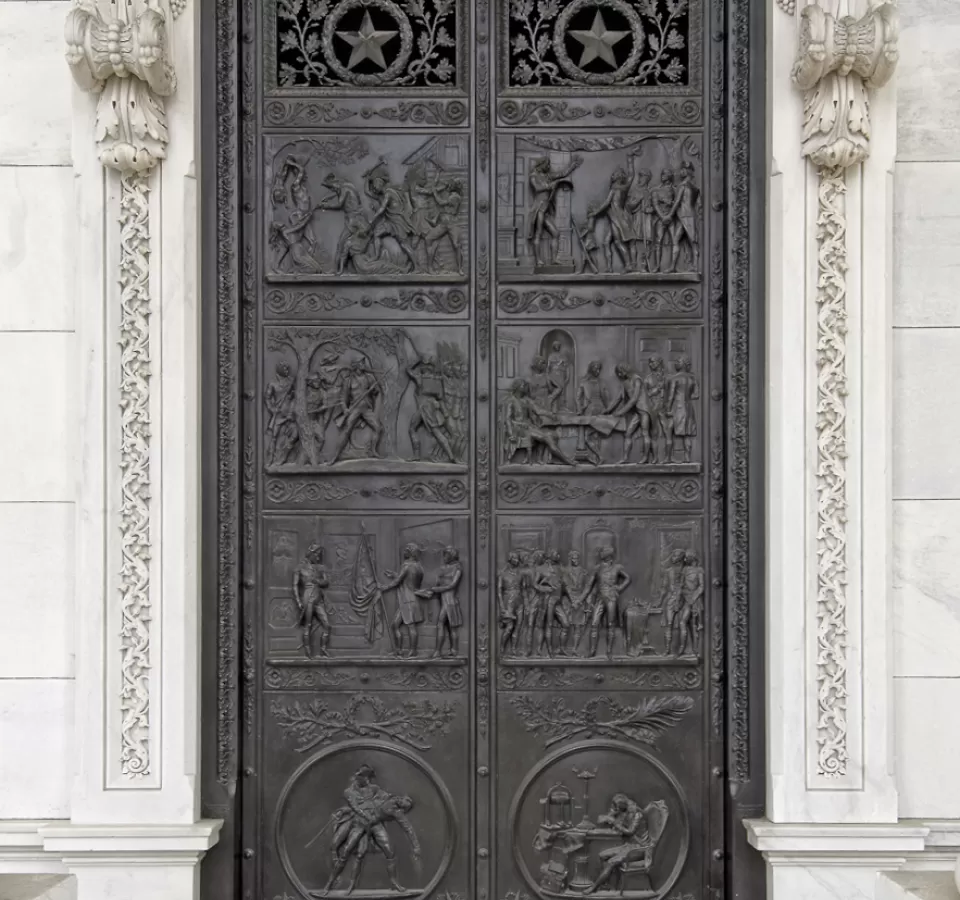Highlights
Artist
Thomas Crawford
Medium
Bronze
Year
1905
The bronze doors of the House wing are comparable to those in the Senate. Each valve consists of three panels and a medallion depicting significant events in American history.
The bronze doors at the east portico entrance of the U.S. Capitol's House wing were designed by the American sculptor Thomas Crawford in Rome in 1855–1857. Upon Crawford's death William H. Rinehart executed the models from the sculptor's sketches in 1863–1867. The models were shipped from Leghorn, Italy, in 1867 but remained stored in the Crypt of the Capitol Building until 1903, when they were cast by Melzar H. Mosman of Chicopee, Massachusetts. The doors were installed in 1905.
Description of Panels
The descriptions below start at the top of each valve and proceed downward.
Left Valve
- Wyoming Massacre, Pennsylvania
During the American Revolution a large proportion of the men of Wyoming Valley, Pennsylvania, joined the Continental Army. A number of Loyalists also remained there, and in 1778 they were joined by British troops and their Indian allies. The settlers who had taken refuge in Forty Fort, near Wilkes-Barre, were outnumbered 1100 to 400. On July 3, 1778, after a desperate battle, the settlers were forced to capitulate. The massacre followed. - Battle of Lexington
General Gage, the British Commander in Boston, heard that the Colonists were collecting arms and ammunition. He determined to prevent rebellion by seizing these supplies. The colonists were warned and during the night of April 18, 1775, Paul Revere and William Dawes rode to alert the Minutemen. As the British troops were marching toward Concord, they met the small militia; here, on April 19, 1775, occurred the famous "shot heard 'round the World" — the beginning of the Revolutionary War. - Presentation of Flag and Medal to General Nathanael Greene
In 1778, Great Britain shifted the attack upon the colonies to the South. Nathanael Greene replaced General Gates as Commander of the colonial army in the South; with the help of loyal American frontiersmen, his forces raided the British camps. This panel depicts General Greene receiving a medal and flag after the Battle of Eutaw Springs on September 8, 1781, in which the British were expelled from South Carolina. - Medallion — Death of General Montgomery
Late in 1775, Congress sent a two-column military expedition to Canada, one column under Richard Montgomery via New York and the other under Benedict Arnold via Maine, hoping to arouse the French Canadians to revolt against the British. The expedition failed. In the attack on Quebec, December 31, 1775, General Montgomery was killed.
Right Valve
- Public Reading of the Declaration of Independence at Philadelphia
On July 4, 1776, the Second Continental Congress adopted the Declaration of Independence. The first public reading was on July 8, 1776, when the Declaration of Independence was officially proclaimed in Philadelphia. - The Signing of the Treaty at Paris Between the United States and Great Britain
The American Revolution ended in October 1781, but it was not until September 3, 1783, that the Treaty of Paris was signed. The panel depicts the negotiations between the United States commissioners and the British representatives. Britain's liberal concessions to the United States were due largely to the efforts of Benjamin Franklin. - Washington's Farewell to His Officers in New York
After the Treaty of Peace was signed, Washington prepared to leave New York for Philadelphia. His officers of the war years gathered at Fraunces Tavern on December 4, 1783, to say good-bye. When he entered the room he could scarcely command his voice. He spoke briefly, and they drank a toast. Washington requested that each man come forward and take his hand. General Knox, who stood nearest, was first to do so. The panel depicts this touching farewell. - Medallion — Benjamin Franklin in His Studio
Benjamin Franklin, an inventor, a signer of the Declaration of Independence and the Constitution, a Member of the Continental Congress, and Minister to France from 1776 to 1785, is shown in his studio studying electricity.

